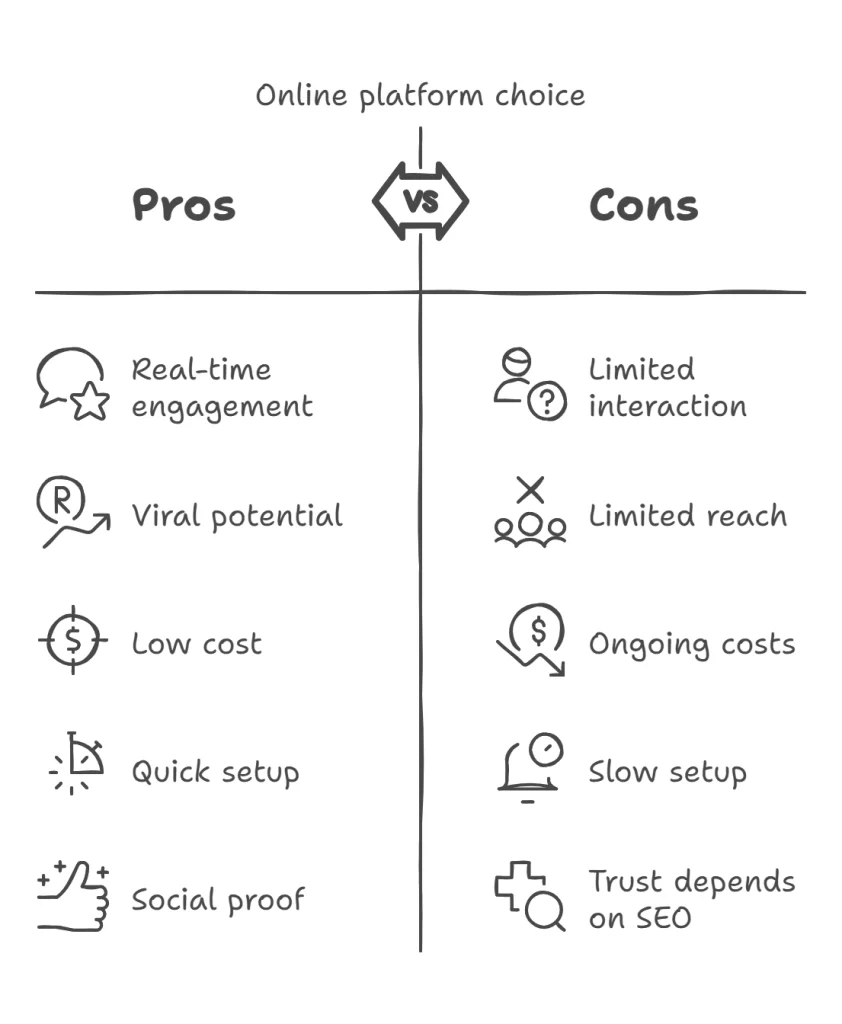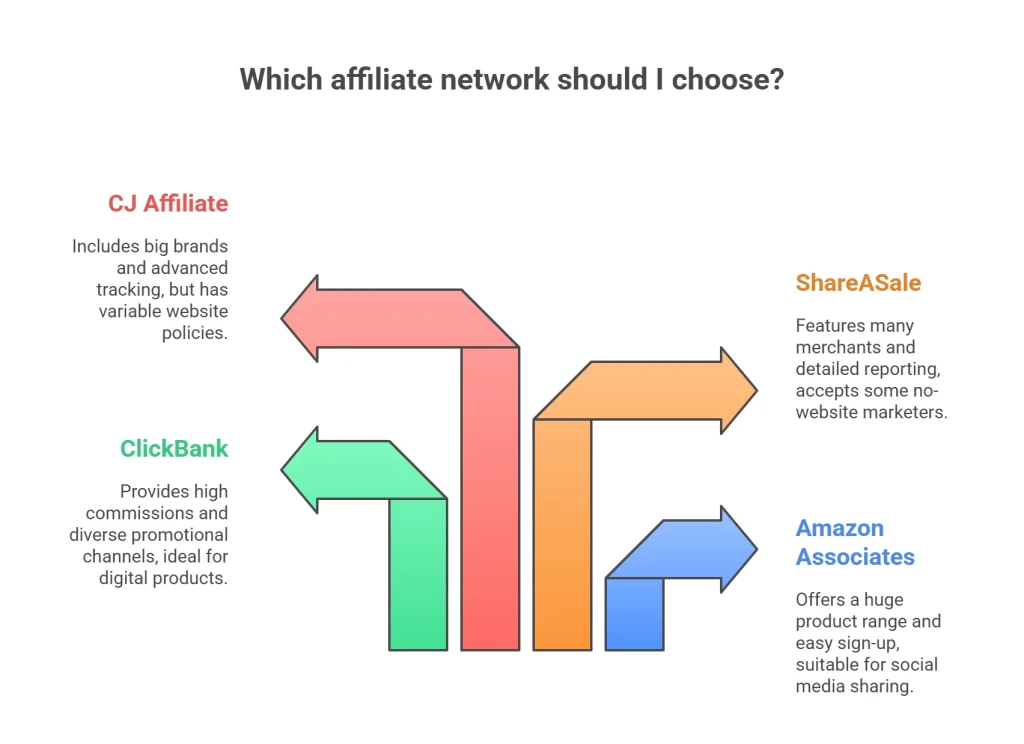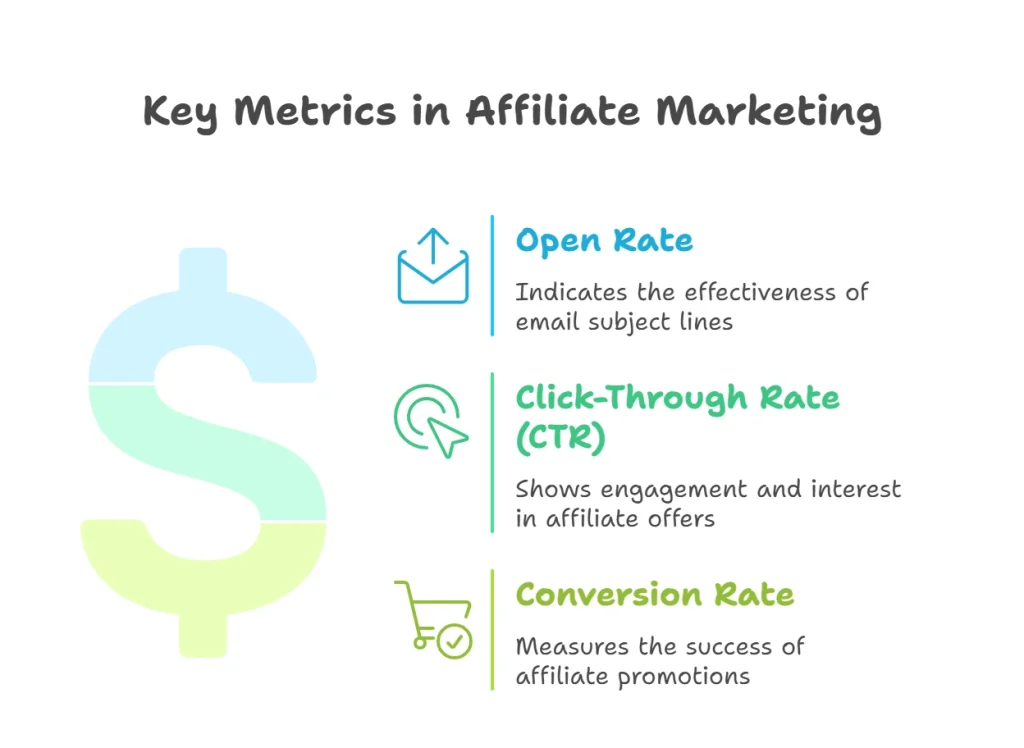 ATTENTION: Want to Learn Affiliate Marketing from Successful Affiliates?
Join this FREE community where successful marketers share their secrets!
Learn directly from highly successful affiliate marketers
Access free, actionable training content regularly
Connect with an active community of over 5,000 members
Network with multiple six-figure earning affiliates
Get your questions answered by real experts
JOIN FREE NOW!
ATTENTION: Want to Learn Affiliate Marketing from Successful Affiliates?
Join this FREE community where successful marketers share their secrets!
Learn directly from highly successful affiliate marketers
Access free, actionable training content regularly
Connect with an active community of over 5,000 members
Network with multiple six-figure earning affiliates
Get your questions answered by real experts
JOIN FREE NOW!
Affiliate marketing often brings to mind websites or blogs as the primary platforms to promote products. However, the question many aspiring marketers ask is: Can I do affiliate marketing without a website? The short answer is yes. You don’t necessarily need a website to start your affiliate marketing journey, thanks to the variety of digital platforms available today. Understanding how to leverage these alternatives can help you build a successful affiliate business without the technical overhead of managing a website.
Why Consider Affiliate Marketing Without a Website?
Setting up and maintaining a website takes time, effort, and some technical knowledge. For beginners, this can be a steep barrier, especially when testing out affiliate marketing as a potential revenue stream. Without a website, you can:
- Start quickly without upfront costs for hosting or domain registration.
- Avoid learning web design and SEO complexities initially.
- Focus on creating content and connecting with audiences on social platforms.
This approach allows you to validate your affiliate strategies before investing in a dedicated site.
Popular Platforms for Affiliate Marketing Without a Website
There are numerous platforms where you can share affiliate links effectively. Let’s explore some of the best channels:
Social Media Channels
Social networks like Facebook, Instagram, Twitter, and Pinterest are excellent for sharing affiliate content. These platforms offer both organic reach and paid promotion options, tailored to various niches.
- Facebook: Join niche-specific groups or create your own page. Use engaging posts to share affiliate products.
- Instagram: Utilize posts, stories, and especially bio links to promote your affiliate offers. The visual nature of Instagram fits product-based promotions particularly well.
- X (formerly Twitter): Share quick, targeted affiliate links backed by valuable content or trending hashtags.
- Pinterest: Create pins linking to your affiliate products or landing pages, benefiting from Pinterest’s search-oriented user base.
Video Platforms
You can build a solid audience on video platforms like YouTube and TikTok without owning a website. Creating valuable, engaging videos and adding affiliate links in descriptions or profiles is a proven strategy.
Email Marketing
Email marketing remains one of the highest converting channels for affiliate sales. By building a mailing list via lead magnets, webinars, or social media, you can promote affiliate offers directly to subscribers. This strategy does not require a website if you use email services and landing page builders.
Key Strategies to Succeed Without a Website
Operating without a website means maximizing other tools and practices:
- Use High-Quality Content: Whether on social media or video, ensure your content adds value and naturally integrates your affiliate products.
- Leverage Link Shorteners and Trackers: Tools like Bitly and Pretty Links help you customize and track affiliate URLs.
- Engage With Your Audience: Build trust by interacting in comments and messages; people buy from those they trust.
- Follow Platform Policies: Always disclose affiliate relationships transparently and adhere to marketing guidelines.
Affiliate Networks That Support No-Website Marketing
Many popular affiliate programs allow marketers to promote products without a website. Some trusted platforms include:
| Affiliate Network | Website Required? | Notable Features |
|---|---|---|
| Amazon Associates | No | Huge product range, easy sign-up, can share links on social media |
| ClickBank | No | Digital products, high commissions, diverse promotional channels |
| ShareASale | Sometimes | Many merchants, detailed reporting, some accept no-website marketers |
| CJ Affiliate (Commission Junction) | Sometimes | Big brands, advanced tracking, variable website policies |
Risks and Considerations to Keep in Mind
While affiliate marketing without a website is viable, it comes with challenges:
- Limited Control: You’re dependent on third-party platforms that can change rules or restrict accounts.
- Less Branding Opportunity: Having a website helps build authority and trust over time.
- Link Restrictions: Some social platforms don’t allow clickable affiliate links directly in posts.
Therefore, while you can start without a website, consider building one as your affiliate business grows. A website gives you a private space to deepen content engagement and generate organic traffic through SEO.
Takeaway
Affiliate marketing without a website is not only possible, but it’s also a practical way for beginners to start earning commissions quickly. By leveraging platforms like social media, video channels, and email marketing, you can connect with audiences and share affiliate offers effectively. Just remember to provide valuable content, stay transparent with disclosures, and respect platform rules. When you feel ready, expanding into website marketing will amplify your success.
For practical tips and tools, check out resources like Smart Passive Income or the comprehensive guides at Affilorama.
Top Platforms to Use When You Don’t Have a Website for Affiliate Marketing
Starting Affiliate Marketing Without a Website: Exploring Effective Platforms
Many people think that having a website is essential to succeed in affiliate marketing. While a website can boost your credibility and SEO, it’s not mandatory. There are numerous platforms you can leverage to launch and grow your affiliate marketing efforts without owning a website. These platforms help you connect with your audience, share affiliate links, and generate commissions effectively.
Social Media Platforms
Social media has transformed the way marketers engage with audiences. Platforms like Facebook, Instagram, and TikTok are valuable for affiliate marketing without a website. Here’s why:
- Large User Base: Billions of people use these platforms daily, giving you huge potential reach.
- Content Variety: You can use photos, videos, stories, and live sessions to promote products creatively.
- Direct Engagement: Social features allow you to interact with your audience in real time, building trust.
Key tip: Use compelling captions and trustworthy reviews. Most social platforms allow you to share affiliate links, but some, like Instagram, benefit from tools like link-in-bio services (Linktree) to host multiple links.
Video Sharing Sites
Video content is booming, and platforms like YouTube and Vimeo are excellent places to share affiliate promotions. Benefits include:
- Evergreen Content: Videos stay online and attract views long after posting, offering passive income opportunities.
- Trust Building: People trust video reviews and demonstrations more than text alone.
- SEO Advantages: YouTube is the second-largest search engine, helping your content be discovered organically.
To succeed, focus on creating useful, honest content such as tutorials or unboxing videos. Include affiliate links in the video description and verbally mention them in the content to encourage clicks.
Online Marketplaces and Forums
Engaging in niche-specific online marketplaces and forums is another way to share affiliate links without a website. Platforms like Reddit, Quora, and dedicated Facebook Groups are great for this. The benefit lies in:
- Targeted Audience: Forums gather users interested in specific topics or products.
- Relationship Building: Participating genuinely builds authority and trust.
- Contextual Sharing: You share your affiliate offers as solutions where relevant, increasing conversion chances.
Always review each platform’s rules regarding affiliate links, as some communities restrict or ban direct promotional content to maintain quality discussions.
Email Marketing Without a Website
Email marketing remains a powerful tool for affiliate marketers. You can build a mailing list using platforms like Mailchimp or ConvertKit without a website by collecting emails through social media or offline sources. Advantages include:
- Direct Communication: Emails reach your audience straight in their inbox.
- Personalized Offers: You can segment lists and send targeted affiliate recommendations.
- Control Over Messaging: Unlike social media, you control your email content and timing.
Make sure your emails provide value, blending helpful content with affiliate promotions naturally to keep readers engaged.
Content Creation Platforms and Microblogs
If you don’t want the hassle of managing a full website, microblogging and content-sharing platforms can serve as your hub. Consider:
- Medium (medium.com): Write articles and include affiliate links where appropriate.
- Substack (substack.com): Publishing newsletters that incorporate affiliate products.
- LinkedIn (linkedin.com): Sharing professional content and product recommendations in your network.
These platforms often have built-in audiences and SEO benefits, so your content can be found more easily without owning a separate website.
Using Landing Page Builders
While not a full website, landing page builders allow you to create simple, focused pages for your affiliate links. Tools like Carrd and Unbounce can help you build sleek pages optimized for conversions. Benefits include:
- Ease of Setup: No technical skills needed.
- Clear CTA (Call-to-Action): Designed to drive clicks and sales.
- Link Aggregation: You can consolidate multiple affiliate offers in one place.
This creates a professional-looking online presence, bridging the gap between full websites and simpler social media profiles.
Comparison Table: Features of Top Non-Website Platforms for Affiliate Marketing
How Social Media Channels Can Boost Your Affiliate Marketing Success
Leveraging Social Platforms to Amplify Affiliate Marketing Revenue
Affiliate marketing thrives on visibility and trust. Social media channels offer an unparalleled opportunity to build both, turning casual followers into loyal customers. By tapping into platforms like Instagram, Facebook, TikTok, Twitter, and LinkedIn, you can spread your affiliate links to a broad, engaged audience without needing a traditional website.
Choosing the Right Social Media Channels for Your Niche
Every social media platform attracts different types of users and content formats. Selecting the right channels for your affiliate marketing efforts ensures your message reaches the ideal audience more effectively.
- Instagram: Great for lifestyle, fashion, beauty, and wellness niches where visuals matter most.
- Facebook: Ideal for broad demographics and community-focused groups centered on specific interests.
- TikTok: Perfect for short, engaging videos targeting younger audiences and viral marketing.
- Twitter: Suited for quick updates, trending topics, and tech or news-related affiliates.
- LinkedIn: Best choice for B2B, professional services, and educational products.
Understanding your audience on each platform allows you to tailor your affiliate promotions, boosting engagement and click-through rates.
Creating Engaging Content That Converts
The key to successful affiliate marketing on social media is content that feels natural, trustworthy, and valuable. Here’s how to create that:
- Educational Posts: Share how-to guides or tips that solve a problem using the affiliate product.
- Product Reviews: Offer honest opinions highlighting both pros and cons to build credibility.
- User-Generated Content: Encourage followers to share their experiences with the product and reshare their content.
- Live Demonstrations: Use live streaming features to demo products in real-time and answer questions instantly.
By combining valuable information with your affiliate links naturally woven into your posts, followers are more likely to trust your recommendations and make purchases.
Benefits of Using Social Media Over a Website Alone
While traditional websites have their place, social media brings unique benefits:
| Feature | Social Media Channels | Traditional Website |
|---|---|---|
| Audience Engagement | Real-time interaction, comments, likes, shares | Limited to form submissions or email |
| Content Virality | High potential for content to go viral and reach thousands quickly | Typically limited organic reach |
| Cost | Mostly free or low-cost promotional boosts | Requires hosting, domain, and maintenance fees |
| Speed of Setup | Account setup in minutes | Website development can take weeks |
| Trust Building | Leverages social proof and community validation | Depends on SEO and design quality |

As shown, social media can accelerate your affiliate marketing success by enabling direct audience connection and rapid content dissemination.
How to Share Affiliate Links Effectively on Social Networks
Affiliate links need to be shared thoughtfully to avoid sounding overly promotional or spamming your followers. Consider these best practices:
- Use Link Shorteners: Clean up long affiliate URLs with tools like Bitly to improve aesthetics and track clicks.
- Incorporate Links in Bio: Platforms like Instagram restrict clickable URLs, so placing your main affiliate link in your bio is strategic.
- Use Stories and Highlights: Stories on Instagram and Facebook allow swipe-up links (for accounts with the feature), providing a direct way for followers to access affiliate offers.
- Pin Posts: Pin your top-performing affiliate posts to the top of your profile for maximum visibility.
- Disclose Affiliate Partnerships: Maintain transparency by clearly marking affiliate links, increasing trust and complying with legal guidelines.
Tools and Resources to Manage Social Media Affiliate Marketing
Handling multiple platforms can get overwhelming. Utilize tools designed to streamline your campaigns and improve performance:
- Hootsuite or Buffer – Schedule posts across multiple social accounts easily.
- Canva – Create eye-catching graphics and videos for your affiliate promotions.
- Later – Specifically good for Instagram planning and link management.
- Sniply – Add call-to-action overlays to shared links, increasing affiliate conversion rates.
- AffPaidSites – Find and promote top performing affiliate products tailored to your audience.
Engagement Strategies to Boost Organic Reach and Affiliate Sales
Growing a loyal social media following that trusts your recommendations takes consistent effort. Here are tactics to foster interaction and promote affiliate sales simultaneously:
- Respond to Comments: Quick, thoughtful replies build community and encourage more engagement.
- Run Giveaways: Offer prizes related to your affiliate products to encourage sharing and participation.
- Collaborate with Influencers: Partner with relevant influencers to expand your reach and credibility.
- Host Q&A Sessions: Live chats or AMA (Ask Me Anything) sessions
Email Marketing Strategies for Affiliate Promotion Without a Website
How to Use Email Marketing to Promote Affiliate Products Without Owning a Website
Affiliate marketing is often associated with having a website, but it’s entirely possible to succeed without one. Email marketing stands out as a powerful method to promote affiliate products directly to your audience. Since email allows for personal and direct communication, you have an excellent chance to build trust and increase conversions without the need for a website.
Building and Managing Your Email List
The cornerstone of email marketing is having a list of subscribers interested in your niche. You can start by collecting emails through social media platforms, online forums, or landing pages provided by email marketing services.
- Leverage Social Media: Invite your followers on platforms like Facebook, Instagram, LinkedIn, or Twitter to subscribe to your email list for exclusive deals or content.
- Use Lead Magnets: Offer valuable freebies such as ebooks, checklists, or tips in exchange for email addresses.
- Join Affiliate-Friendly Email Platforms: Platforms like Mailchimp and ConvertKit provide tools to build and automate email campaigns without needing your own website.
Crafting Effective Email Content That Converts
Your emails should focus on providing value while subtly integrating affiliate promotions. Avoid hard-selling, which might push your subscribers away.
Content Types to Send
- Informational Emails: Share tips, tutorials, or insights related to your niche, mentioning affiliate products naturally as solutions.
- Product Reviews: Write honest, detailed reviews about the affiliate products you’re promoting to build trust.
- Exclusive Offers: Share discount codes or bonuses available only to your email subscribers.
- Personal Stories: Share your own experiences with the products to create emotional connections.
Using Tracking and Analytics to Improve Campaigns
Most email marketing services offer tracking features that let you see open rates, click-through rates, and conversions. Use this data to optimize your campaigns.
| Metric | What It Means | Why It Matters for Affiliate Marketing |
|---|---|---|
| Open Rate | Percentage of subscribers who open your email | Indicates how compelling your subject line is |
| Click-Through Rate (CTR) | Percentage of readers who click links in your email | Shows engagement and interest in your affiliate offers |
| Conversion Rate | Percentage of clicks that result in a sale or desired action | Measures the effectiveness of your affiliate promotion |
Maximizing Reach Without a Website
Since you do not have a website, it’s essential to create alternative landing points where your audience can learn more about your affiliate products. Use third-party landing page builders or content-sharing platforms:
- Leadpages: Build standalone landing pages that capture emails or house affiliate links.
- Medium: Publish articles that include your affiliate links subtly embedded within valuable content.
- Linktree: Create a bio link where you collect multiple affiliate offers and share this link in your email or social profiles.
Compliance and Best Practices
Remember to always follow email marketing laws and affiliate program rules. Include an easy way for subscribers to unsubscribe, disclose affiliate links transparently, and avoid spamming your list.
- CAN-SPAM and GDPR Compliance: Make sure your emails include your contact information and clear unsubscribe options.
- Affiliate Disclosure: Clearly state when your email contains affiliate links to maintain transparency and trust.
- Consistency is Key: Send emails regularly but refrain from overwhelming your subscribers.
Enhancing Engagement Through Personalization
One of the major advantages of email marketing is the ability to tailor messages to your subscribers’ interests.
- Use segmentation to group subscribers based on behavior or preferences.
- Address subscribers by their first name to build rapport.
- Send personalized product recommendations based on previous interactions or expressed interests.
By employing these strategies, you can effectively promote affiliate products through email marketing without owning a website. The key is to nurture your subscriber base, provide valuable content, and integrate your affiliate offers naturally and transparently.
For further assistance on mastering email marketing techniques, explore resources like DigitalMarketer and Smart Passive Income to keep refining your approach.
Pros and Cons of Affiliate Marketing Without Owning a Website
Exploring Affiliate Marketing Without a Website
Affiliate marketing is a popular way to earn passive income by promoting products or services and earning a commission on sales. While many associate affiliate marketing with owning a dedicated website or blog, it’s entirely possible to succeed without one. Let’s delve into the advantages and disadvantages of doing affiliate marketing without having your own website.
Advantages of Affiliate Marketing Without a Website
Choosing not to own a website can simplify your startup process and reduce upfront costs. Here are some prominent benefits:
- Lower Initial Investment: Without the need to purchase hosting, domain names, and website development, your entry cost is significantly reduced.
- Faster Setup and Execution: You can immediately begin promoting affiliate products using social media platforms, email marketing, or other channels.
- Leverage Existing Platforms: Using platforms like Instagram, Facebook, or YouTube gives you access to a broad audience without building traffic from scratch.
- Direct Engagement: Social media and email list marketing enable personal connection and direct interaction with followers, which can boost conversion rates.
- Reduced Maintenance: No worry about website updates, security fixes, or content management systems.
Drawbacks to Consider
While skipping a website has benefits, it also comes with challenges that can affect your long-term success.
- Limited Control Over Content: Platforms such as social media or marketplace sites set the rules, and your account can be suspended or restricted at any time.
- Brand Building Is More Difficult: A website serves as your digital storefront, where you create a consistent brand image. Without it, it’s tougher to establish authority or trust.
- Dependency on Third-Party Platforms: Traffic and sales rely heavily on algorithms of social media or video platforms, which can change unexpectedly.
- Harder to Optimize for Search Engines: SEO benefits from owned websites where you can publish evergreen content that attracts ongoing organic traffic, which is not as feasible solely through other channels.
- Tracking and Analytics May Be Limited: While some affiliate networks provide tracking, comprehensive analysis of visitor behavior is easier on personal websites.
Effective Methods to Promote Affiliate Products Without a Website
Despite these challenges, many marketers successfully leverage other channels. Here are some strategies you can use:
- Social Media Marketing: Regular posts, stories, reels, and live sessions on platforms like Instagram, TikTok, Facebook, and Twitter can showcase affiliate products effectively.
- Email Marketing: Building an email list lets you nurture leads and promote offers directly.
- YouTube Videos: Create product reviews, tutorials, or unboxings integrating your affiliate links in video descriptions.
- Forums and Online Communities: Engage in niche-specific forums and share affiliate recommendations where appropriate (avoiding spammy behavior).
- Use Link Aggregators and Landing Pages: Tools like Linktree or Campsite allow you to create a centralized hub for affiliate links that can be shared across profiles.
Comparing Affiliate Marketing Channels With and Without a Website
| Aspect | Without Website | With Website |
|---|---|---|
| Initial Cost | Low to none | Moderate (hosting, domain, design) |
| Control Over Content | Limited | Full control |
| Traffic Sources | Third-party platforms only | Organic SEO, paid ads, social media |
| Brand Building | Challenging | More effective and consistent |
| Long-Term Sustainability | Vulnerable to platform changes | More sustainable via content ownership |
| Analytics | Basic via affiliate networks | Advanced insights via website tools |
Final Thoughts on Starting Without a Website
If you’re wondering, “Can I do affiliate marketing without a website?”, the answer is yes. Many affiliates begin without websites to test product niches and build initial income streams. However, for those aiming to scale, build a personal brand, and secure long-term success, eventually investing in a website can provide crucial advantages.
Starting without a website allows you to experiment with multiple approaches and learn what works best for your audience. Focus on delivering value, understanding your followers’ needs, and maintaining transparency in your promotions to build trust. Over time, creating a website can amplify your credibility and funnel organic growth for your affiliate business.
For additional guidance on affiliate marketing strategies, visit Affilorama and ShoutMeLoud, two comprehensive resources dedicated to affiliate marketers at all levels.
Conclusion
Affiliate marketing without a website is not only possible but can also be highly effective when approached with the right strategies. By leveraging popular platforms like social media channels, email newsletters, and trusted marketplaces, you can reach a broad audience and promote affiliate products successfully. Social media networks enable you to connect directly with followers, share engaging content, and drive sales without needing a dedicated website. Meanwhile, email marketing remains a powerful tool to nurture relationships and promote offers to interested audiences, even without a personal web page.
However, it’s important to weigh both the advantages and challenges. Without a website, you save time and cost on site maintenance, and you can focus entirely on building an audience in places they already frequent. On the downside, lacking a website might limit your control over branding and reduce your chances of organic search traffic. Despite this, many marketers have built thriving affiliate businesses by consciously choosing platforms that fit their strengths.
Ultimately, your success hinges on how well you engage your audience and deliver value. Affiliate marketing without a website requires creativity and persistence, but it offers flexibility and accessibility, especially for beginners or those testing the waters. By combining the right platforms and consistent promotion tactics, you can build a sustainable affiliate income stream even without owning a website.

